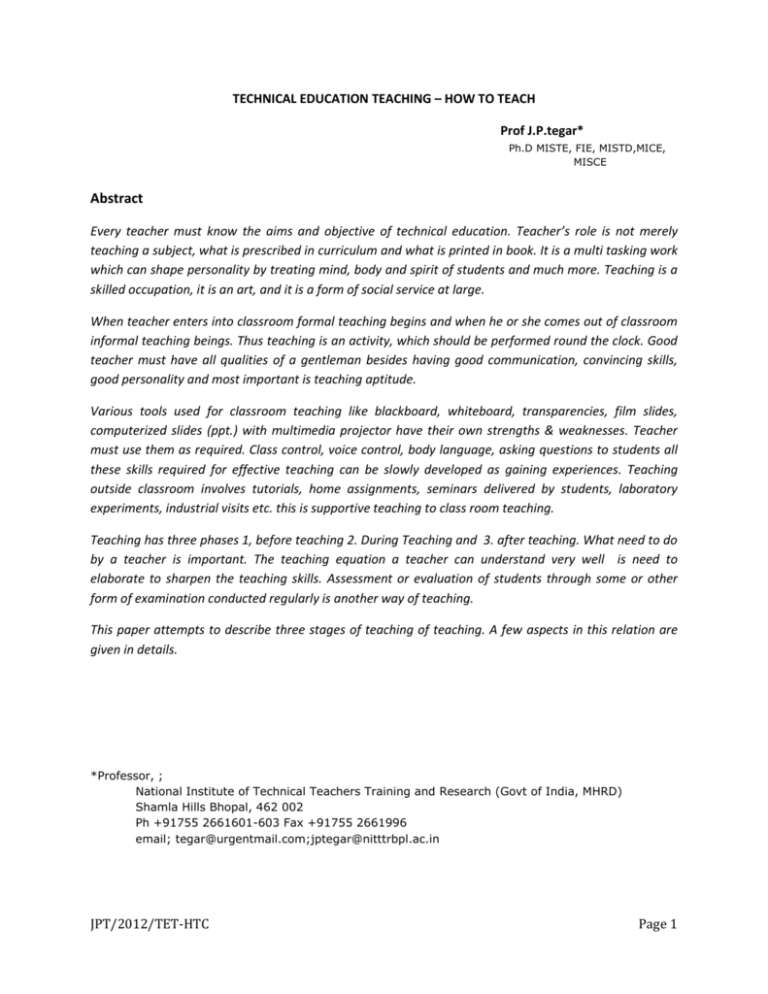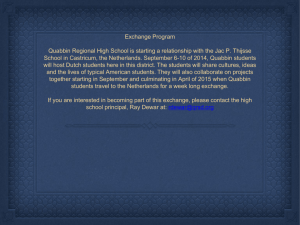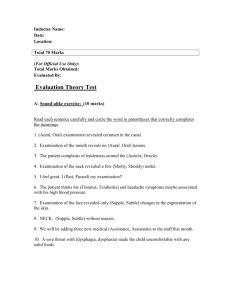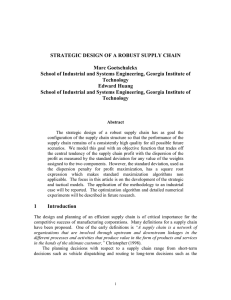Teaching through Methods/strategies : Class room teaching
advertisement

TECHNICAL EDUCATION TEACHING – HOW TO TEACH Prof J.P.tegar* Ph.D MISTE, FIE, MISTD,MICE, MISCE Abstract Every teacher must know the aims and objective of technical education. Teacher’s role is not merely teaching a subject, what is prescribed in curriculum and what is printed in book. It is a multi tasking work which can shape personality by treating mind, body and spirit of students and much more. Teaching is a skilled occupation, it is an art, and it is a form of social service at large. When teacher enters into classroom formal teaching begins and when he or she comes out of classroom informal teaching beings. Thus teaching is an activity, which should be performed round the clock. Good teacher must have all qualities of a gentleman besides having good communication, convincing skills, good personality and most important is teaching aptitude. Various tools used for classroom teaching like blackboard, whiteboard, transparencies, film slides, computerized slides (ppt.) with multimedia projector have their own strengths & weaknesses. Teacher must use them as required. Class control, voice control, body language, asking questions to students all these skills required for effective teaching can be slowly developed as gaining experiences. Teaching outside classroom involves tutorials, home assignments, seminars delivered by students, laboratory experiments, industrial visits etc. this is supportive teaching to class room teaching. Teaching has three phases 1, before teaching 2. During Teaching and 3. after teaching. What need to do by a teacher is important. The teaching equation a teacher can understand very well is need to elaborate to sharpen the teaching skills. Assessment or evaluation of students through some or other form of examination conducted regularly is another way of teaching. This paper attempts to describe three stages of teaching of teaching. A few aspects in this relation are given in details. *Professor, ; National Institute of Technical Teachers Training and Research (Govt of India, MHRD) Shamla Hills Bhopal, 462 002 Ph +91755 2661601-603 Fax +91755 2661996 email; tegar@urgentmail.com;jptegar@nitttrbpl.ac.in JPT/2012/TET-HTC Page 1 Introduction: Goethe said “thinking is easy, acting is difficult and to put one’s thought into action is the most difficult thing in the world” Teaching is linked with a basic concept of “learning”. Learning is change in behavior and transformation/development of skills as a result of acquiring information and experiences. The function of education is considered to be the adjustment of man to his environment, which means his adaptation to and reconstruction of his surroundings for his own benefit and that of society. In the traditional approach to teaching, the professor lectures and assigns readings and well-defined convergent single-discipline problems, and the students listen, take notes, and solve problems individually. Alternative pedagogical techniques have repeatedly been shown to be more effective and much more likely to achieve the objectives set forth in the preceding section. In present scenario teaching is much more systematic and a responsive task for a teacher. Teaching offers the opportunity to serve the mankind in a very important matter of gaining knowledge and information. Technological innovations have brought about profound changes in various fields including teacher training. Technical teaching classified in to four groups, theory teaching, practical teaching, problem solving teaching and diagrammatic/drawing teaching. All these required a sound knowledge of subject, communications kills, aptitude and understanding of how to teach. How to teach: Teaching-Teacher-Technology TEACHING: The question is what is teaching? Broadly it know-how of specific content, classroom management, and skill in methods & instruction OR Teaching = Fn (Lb Tc Cp Ae Ra) Teaching is function of Learner behavior, Teacher competence, Curriculum plan, Resources availability, Teaching is broadly divided into three phases, a teacher is suppose to go through Before Teaching During Teaching after teaching Before Teaching: It involve the overall preparedness of teacher to take initiatives and action before entre to the classroom for face to face interaction/ instruction. Followings may be the important to look into at before teaching stage. JPT/2012/TET-HTC Page 2 Learner behavior: a teacher must be well aware of entry level of the student, his prior learning and maturity level. A sample of the learner target population should be tested to determine if their entry behavior Knowledge, Skills, and Abilities (KSA) match the proposed level of instruction/teaching Teacher competence: ability of teachers or would-be teachers to demonstrate specific, predetermined, and desirable pedagogical techniques coupled with subject-matter knowledge Curriculum plan : Curriculum plan contains followings Curriculum: be clear about what and why to teach by clinical analysis of curriculum, the aims/objective and rationale for the content should well understood. Teaching and examination schemes along with specification table and time for practical hrs must be appreciated. Content matter: the scope of content matter of a particular subject/area must be analyzed on the components such as Facts, Concept, Principles, Procedures and Applications. This analysis must matched with the entry level of the students Objectives: keeping above analysis in mind, teachers are expected to formulate objectives for the curriculum defined content based on time availability and session planned. Pre requisite knowledge and learning must be well thought before formulating the objectives Session plan: considering the abilities and interest of the learner organize the teaching in a meaning full sequence thematically, chronologically spatially in part-to-whole OR whole -to -part order. Teaching method or Strategies must be clear in mind and teachers should be confident to apply/ use these methods /strategies. Handout/notes: in matching with session plan, develop the main points, the examples, solving questions and answers, formulas, complex analysis etc. Feed back by Peer and rehearsals: It is always better to have opinion of your peer on all the above mentioned points; one may rehear the same at least once so that the delivery of teaching should for ears and not for eyes Time: Time management and resource control is very essential to deal with, and teachers are expected to accomplish at least 95% on this account Resources availability: Teaching resources in the sample include books, interactive learning objects and tools in laboratories, film clips, sound files, photographs, maps and teacher support materials, ICT web based information, laptop, software and hardware and conducive academic environment. During teaching: This mainly involves oral teaching techniques. For effective oral teaching teacher must have good narration, good description and good explanation skills. This has to be supported by following tools or methods depending upon needs. JPT/2012/TET-HTC Page 3 Teaching through body and personality Black board & chalk- This is conventional method used by, almost every teacher, along with oral teaching, from schools to post graduation. Various important points, diagrams, derivations, graphs etc. can be drawn on blackboard and erased easily. This is very cheap method as compared to it’s new versions such as transparencies, film slides, computerized slides. Use of blackboard along with oral explanation makes teaching live Computerized slides- A modern and high tech classroom should have a computer and a projector which is interfaced with computer. Slides prepared using say power point can be can be sent to projector from computer digitally and image is projected on screen. One can prepare various slides on computer and store them on CD, while going for lecture carry this CD with you, load it on computer & use whichever slides you want. One can store various slides on laptop. Carry laptop to lecture room and use the slides. Here since the slides are available on hard disk one can make changes on slides during lecture. Using coloured transparencies may be very costly affair but on computer it is very effective and cheaper. One slides are available on computer, they can be download them from site. Class discipline- Teacher has to maintain discipline in class during lecture. Last benchers very often keep on chatting during lecture, there may be murmuring in the class during the lecture, which increases especially when you start writing on board, all these things one has to control for maintaining friendly environment to learn in the class. Speech- A teacher must have good control on his/her voice. While delivering lecture your tone & volume must be according to size of classroom & students’ strength. You must be properly audible till last bench. Your confidence in delivering lecture should be reflected in your tone. Like an actor in drama, teacher must understand type of statement to be delivered and accordingly change voice, tone volume etc. for effective teaching. Body language- Your presence in the class should develop enthusiasm among students. Your movement in the class should keep the class live, this is especially important when you are engaging last lecture of the day, when the subject you are teaching is boring and/ or you are teaching that subject 4 or 5th time. Questioning for feedback- This is perhaps one of the most important devices of teaching. It is by means of questions that the teacher keeps in close touch with his class. It is through questioning that knowledge is shared in the class. A teacher aptly said: “I keep six honest serving men: They taught me all I know: Their names are What & Why & When and How & Where & Who.” Questions by students- As a teacher should ask good number of questions to students and you also should encourage students, so that they can ask questions to you Either during class, or outside class. Teaching through Methods/strategies : Class room teaching is to be supported by following ways. JPT/2012/TET-HTC Page 4 Tutorials- Students are required to solve problems, questions etc. in a special tutorial class, in your presence. Home assignments- Due to availability of limited tie, it is not possible to solve adequate problems on each topic during tutorial session. So such additional problems should be given to students as home assignment. Convince them that they should not copy these assignments of each other but they should try to solve on their own. Correct these assignments, not merely signing them, and explain their mistakes if any. Student’s presentation- Ask a group of 2-3 students to prepare on some small topic and they should present their preparation in front of the full class. To begin with topics could be from syllabus later on topics should be beyond syllabus. This will improve presentation skill of students. While preparing for the given topic they should refer to multiple books. They may also collect information from Internet. Laboratory experiments- Various principles, methods taught in theory class should be verified by performing actual experiments in laboratory. Give them more & more experiments. Simulation- Many of the times it is not possible to perform certain experiments due to time constraints, complexity in experiments, need of costly equipments etc. in such situations at least provide them simulation tools and they should try out these experiments by simulation. Mini project- Encourage students to develop small but working projects. This will teach them how to design what are practical difficulties, difference between theory and practice etc. This will also give them hands on experience & build their confidence. Industrial visits- Organize industrial visits for students. Let them see how various things are manufactured in industry, how they are tested what kinds of equipments, machinery is required for this. After their graduation what kind of job they may have to do in industry. Teaching Through Evaluation: Assessment or Examination is a part and parcel of education system. Conventionally there is written examination, practical, oral examination and laboratory experiment report i.e. journal or term work evaluation. The assessment can be of following ways Formative assessment: Formative Assessment is a tool used by the teacher to continuously monitor student progress in a, supportive environment. It involves continuous feedback, an opportunity for the students to improve performance, take advice. Formative Assessment is thus carried out during teaching i.e. a course of instruction Summative assessment: The purpose of summative assessment is to evaluate student learning at the end of teaching an instructional unit by comparing it against some standard or benchmark. Summative assessments are often high stakes, which means that they have a high point value. Examples of summative assessments include: a midterm exam JPT/2012/TET-HTC Page 5 a final project a paper a senior recital The most important factor in evaluation is unbiased behavior of teacher. Teacher has to train them for all these examinations and finally he or she has to decide their marks from failure to first class. Natural tendency of the students is, they do not study regularly for their final examination. They study is last month before examination. Teacher has to make them study regularly, by conducting tests, quizzes and orals on every fortnight. You may also conduct orals examination. Corrected or assessed test papers when they are given back to students we can discuss about their mistakes, which will help them to improve. How in orals & interviews questions are asked to judge their fundamental knowledge, this can be taught to them by conducting mock orals. Thus by using various examination & evaluation techniques you can teach them to study better and your student’s performance will teach you what kind of improvements are required in your teaching. After teaching: what is after teaching is big question mark? Actually it includes self evaluation and evaluation by learners. Many approaches are being used by teachers to do this. However few suggested may be very effective for the teachers who are new in the profession. Self evaluation on teaching : Teacher may evaluate teaching on following reference; 1. The expected activities during teaching 2. 3. 4. 5. 6. 7. 8. 9. 10. 11. 12. I prepared well before coming to the class I explained properly the important points in the lesson I motivated students to ask question I encouraged discussion in the class room I used learning aids in my lecture/teaching I gave assignments to my students I encouraged independent study habits among students I relate the concepts to applications I listen to the view points of students I encouraged students to express their feelings I given feedback and useful suggestions for improvement while returning answer scripts/ assignments I completed the session on time I was punctual to the class I summarized the lesson at the end of the class 13. 14. 15. Marks : A= 3 B= 2 C= 1 Total marks scored and report 40-45 - Excellent teaching perception 30-39 - need improvement JPT/2012/TET-HTC Yes Partially No A A A A A A A A A A A B B B B B B B B B B B C C C C C C C C C C C A A A B B B C C C SCORE:------------------ Page 6 15-38 - Just a teacher Students evaluation on teaching: Similarly an evaluation can be obtained from learners adopting the same approach a suggested format will be as follows; student may be asked to rate the teaching by drawing circle on appropriate letter on following statement; 1. Teacher ….. 2. 3. 4. 5. 6. 7. 8. 9. 10. 11. 12. 13. 14. was punctual to the class seems well-prepared for the class communicates clearly makes good use of examples and illustrations is actively helpful when students have academic difficulties completes the planned teaching on time meets the class regularly (rarely cancels) is fair to all students in evaluation/ grading inspires me is providing more matters than in text book is holding the attention of students throughout the class is encouraging discussion in the class is giving useful explanation while returning answer papers and assignment Overall, the lecturer is one among the best teachers 15. Marks : A= 3 B= 2 C= 1 Total marks scored and report 40-45 - Excellent teaching perception 30-39 - need improvement 15-38 - Just a teaching Strongly agree A A A A A A A A A A A A A Partially agree B B B B B B B B B B B B B Not agree C C C C C C C C C C C C C A B C SCORE:------------------ Peer evaluation teaching: Further peer / colleague evaluation is also possible teaching. A table is evolved to have peer evaluation; Teaching Session Observation Form Peer/colleague name:-------------------------------------------------------------------------S.No Teaching indicators I Presentation Introduction Gaining Attention (Motivation) Information the learners of the behavioural objectives Recall of Pre-requisite learning Development Content appropriateness Methodology Question-Answer Technique Trainees active participation in 1. 1.1 1.2 1.3 2. 2.1 2.2 2.3 2.4 JPT/2012/TET-HTC Excellent Very Good Good Fair Poor 5 5 4 4 3 3 2 2 1 1 5 4 3 2 1 5 5 5 5 4 4 4 4 3 3 3 3 2 2 2 2 1 1 1 1 Remarks/ Comments Page 7 S.No Teaching indicators 1. 2. 3. III 1. 2. 3. 4. IV learning Consolidation Recapitulation of points covered Assessing the performance Giving Assignments for Practice, Retention and Transfer of learning Use of Media and Material Chalk Board OHP Any other material & media Delivery Voice Audibility Quality Speed Gestures & Mannerisms Overall Impression V Any Suggestions for Improvement 3. 3.1 3.2 3.3 II Excellent Very Good Good Fair Poor 5 5 5 4 4 4 3 3 3 2 2 2 1 1 1 5 5 5 4 4 4 3 3 3 2 2 2 1 1 1 5 5 5 5 5 4 4 4 4 4 3 3 3 3 3 2 2 2 2 2 1 1 1 1 1 Remarks/ Comments Conclusion : the important thing in teaching is to have teaching technology and passion for this profession. The simple equation of teaching presented in the paper has been tried out during induction training of technical teachers and these trained teachers on students in classroom sittings. It is hoped that this model will be very useful especially to the new teachers. References: 1. E.G. Vedanayagam, Teaching Technology for college Teachers , Sterling Publication Pvt Ltd New Delhi 2. Joseph Lowman , Mastering the Techniques of Teaching , PHI 3. Davis, Barbara Gross. Tools for Teaching. San Francisco: Jossey-Bass Publishers. 1993 4. McKeachie, Wilbert, et al. McKeachie’s Teaching Tips: Strategies, Research, and Theory for College and University Teachers. 12th ed. Boston: Houghton Mifflin, 2005. 5. Lani Florian, Preparing Teachers to Work in Inclusive Classrooms: Key Lessons for the Professional Development of Teacher Educators from Scotland’s Inclusive Practice Project , Journal of Teacher Education September/October 2012 63: 275-285, first published on June 11, 2012 6. Helen M.G Watt and Paul, An introduction to Teaching Motivation in Different countries…..Asia – Pacific Journal of Teacher Education, Aug 2012 7. Bruce W. Tuckman Peabody Journal of Education, Volume 70, Issue 2, 1995, Special Issue: Teacher Effectiveness: A Look at What Works JPT/2012/TET-HTC Page 8 8. Murray, Donald M. Learning by Teaching: Selected Articles on Writing and Teaching. Boynton/Cook Publishers, Inc., 206 Claremont Ave., Montclair, NJ 07042 9. Induction Training Programme for Engineering College Teachers, Module 1 & 2 national Institute of Technical Teachers Training , Bhopal India 10. J.E. Stice, “A First Step toward Improved Teaching.” Engr. Education, 66(5), 394–398 (1976). JPT/2012/TET-HTC Page 9









